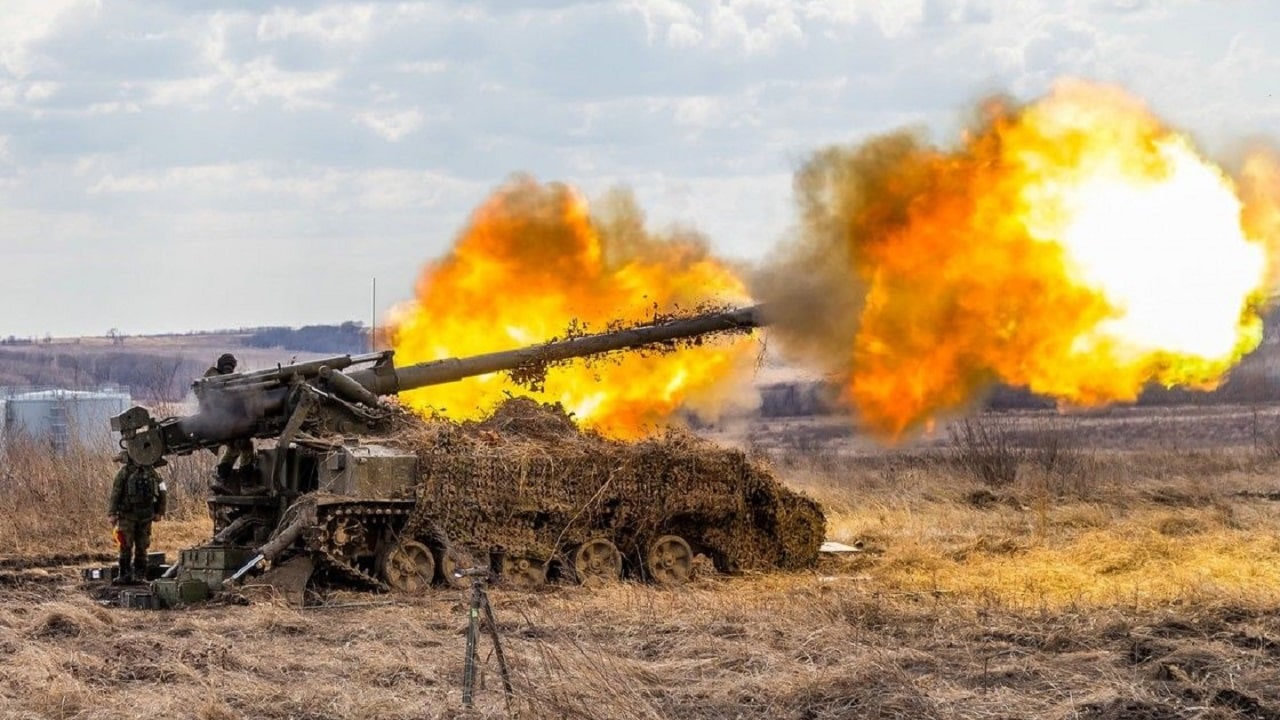Video – Russia Lost Another Self-Propelled Mortar In Recent Fighting: The war in the Eastern Donbas region of Ukraine has turned into an artillery duel that has earned comparisons to the brutal slug match that occurred on the Western Front during the First World War.
However, today’s modern weapons are far more accurate – while unmanned aerial systems (UAS), or drones, have further allowed each side to pinpoint their enemy’s position.
Though both sides employ significant numbers of towed howitzers, the fighting in Ukraine has also seen the deployment of “self-propelled” weapons that enable its operators to target the enemy, fire, and move before taking counter-fire.
Apparently, the latter part was forgotten by the Russian military this week.
Video circulated on social media on Thursday showed a Russian 2S4 Tyuplan 240mm self-propelled mortar engulfed in flames after taking a direct hit from a battery of the Ukraine 72nd Brigade in the Donetsk Oblast.
The tracked vehicle had apparently attempted to conceal its position around some industrial buildings but was likely spotted by the Ukrainian drones – which also captured the aftermath of its destruction.
According to the social media account Ukraine Weapons Tracker (@UAWeapons), it was the fifth loss of a Russian 2S4 since the start of the invasion.
Quite the Tulip
The 2S4 Tyuplan (Russian for “Tulip”) is currently the largest mortar system in use today, and its main armament is a 240mm (9.4 inch) mortar, while it is also equipped with a 7.62mm PKT machine gun.
Due to the size of the mortar, it is mounted externally on a self-propelled, tracked chassis rather than in an enclosed superstructure or turret.
For firing, the gun must be pivoted at the rear of the vehicle and anchored to the ground with the use of a massive recoil-absorbing base plate.
The Tulip first sprouted in 1972, and it was first employed by the Soviet Army during the Afghan War of the 1980s.
A total of 588 of the self-propelled heavy mortars were built, while a number were exported to Iraq and subsequently used in the Iran-Iraq War.
Reportedly some two dozen were also provided to Syria, though it has yet to be discovered if those remain in service.
According to the open-source website Oryx, Russia had nine in active service in Ukraine, and this is the fifth one lost to date. Some 400 are believed to be in storage, and it is unclear why the Kremlin has pressed those into service.
There are several factors to consider.
Though the 2S4 has a reported range of 9,560 meters (5.9 miles) using standard high-explosive rounds and a range of 20,000 meters (12.5 miles) with extended-range munitions, the set-up time for the mortar is slow, while its rate of fire is just one round per minute.
Moreover, due to the large size of the mortar and the weight of the ammunition, a crane is required for loading.
However, in addition to HE rounds, the 2S4 is capable of firing laser-guided munitions.
Originally the Tyulpan was also capable of firing ZBV4 shells with nuclear warheads.
Extra ammunition is typically carried in a separate vehicle, along with the support troops needed to operate the mortar. In total, a driver and commander usually travel in the Tulip, while the additional troops are carried in a separate armored personnel carrier (APC).
Thus while other vehicles can more easily “shoot-and-scoot,” those operating the 2S4 Tyuplan have to hope they take out the enemy and don’t come under counter-fire.
This week it seems at least one crew wasn’t all that lucky.
#Ukraine: A Russian 2S4 Tyulpan 240mm self-propelled mortar was destroyed by the Ukrainian 72nd Brigade in #Donetsk Oblast. This is the 5th loss of this potent type. pic.twitter.com/2aiBsdiXsc
— ???????? Ukraine Weapons Tracker (@UAWeapons) March 2, 2023
MORE: B-21 Raider: China Should Fear America’s New Stealth Bomber
MORE: H-20: China Is Building a New Stealth Bomber
MORE: Is Russia’s Su-57 Felon Stealth Fighter a Total Bust?
MORE: Merkova: Israel Has A Super Tank
Author Experience and Expertise
A Senior Editor for 19FortyFive, Peter Suciu is a Michigan-based writer. He has contributed to more than four dozen magazines, newspapers, and websites with over 3,200 published pieces over a twenty-year career in journalism. He regularly writes about military hardware, firearms history, cybersecurity, politics, and international affairs. Peter is also a Contributing Writer for Forbes and Clearance Jobs. You can follow him on Twitter: @PeterSuciu.

